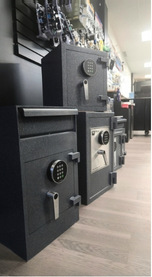Vancouver’s Trusted Locksmith Team
Emergency Locksmith Vancouver
Vancouver’s Trusted Locksmith Team
Need an emergency locksmith in Vancouver? Our mobile team handles everything related to locks, keys, and assistance when your locked out. Services for your car, house, and business.
Earning The Trust of Communities
Since 1993

Fill out our form and we will call you ASAP
Safe & Secure Locksmith Services
Services for your car, home, and business. 24/7 locksmith services to assist you at anytime.
Automotive Locksmith
Our auto locksmith team gets you back on the road fast with key programming, lockouts, and all keys lost solutions.
Residential Locksmith
From lock changes to rekeying and emergency lockouts, we keep your place secure and your family safe.
Commercial Locksmith
We handle master key systems, high-security locks, access upgrades, and emergency services.
How to Book with Safe & Secure Locksmith
Getting the help you need is quick and convenient! Choose one of the following options:
Call to Book
Speak directly with one of our friendly locksmiths by phone. We'll schedule a locksmith right away.
Book Online
Book an appointment directly on the trusted Square platform. We will call you before the appointment to confirm.



SAFE & SECURE LOCKSMITH SHOP
LOCATED 4105 MACDONALD STREET, VANCOUVER.
Years In Business
Commercial Clients
Locksmith Services



Commercial Clients
Locksmith Services
SAFE & SECURE LOCKSMITH SHOP
LOCATED 4105 MACDONALD STREET, VANCOUVER.
Why Choose Safe & Secure Locksmith
Fast Response
Our team provides fast response times across Vancouver and the lower mainland.
24/7 Emergency Locksmith
We are available around the clock to assist with emergency locksmith services.
Local & Fast
We’re already nearby. Our mobile locksmiths reach you quickly with same-day service for homes, cars, and businesses.
Safe & Secure Locksmith Questions
Frequently Asked Questions
Are your locksmith services available 24/7 in Vancouver?
Yes! Safe & Secure Locksmith offers 24/7 emergency locksmith services across Vancouver and nearby areas. Whether it’s a car lockout, lost key, or broken lock, our mobile locksmiths are always on standby day or night to get you back inside quickly and safely.
Do you offer mobile locksmith service for emergencies?
Absolutely. Our mobile locksmith team is equipped to handle emergencies anywhere in Vancouver, from vehicle lockouts to home rekeying and key replacements. We bring all the tools and technology right to your door, saving you time and stress.
Where is the Safe & Secure Locksmith shop located, and what are your hours?
Our locksmith shop is located in Kitsilano, Vancouver, and open Monday to Friday from 8:30 AM to 5:00 PM. You can stop by to duplicate keys, repair locks, or browse security hardware. Need help after hours? Our 24/7 mobile locksmiths are just a call away.
Are all your locksmiths licensed?
Yes! Every locksmith at Safe and Secure Locksmith is fully licensed, ensuring you receive professional, trustworthy, and reliable service every time.
Can you make or program car keys on-site?
Yes, our automotive locksmiths can cut and program car keys on-site, including smart keys, transponder keys, and fobs for most makes and models. Whether you’ve lost all your keys or just need a spare, our mobile car key service comes straight to you.
How quickly can a technician arrive for emergency lockout service?
In most cases, our emergency locksmiths arrive within 20 to 30 minutes, depending on your location in Vancouver. We prioritize urgent calls like car, home, and office lockouts, ensuring fast and professional assistance whenever you need it.
Safe & Secure Locksmith Reviews
What our Customers Say About Us
Homeowners, drivers, and businesses choose Safe & Secure Locksmith for fast response times, honest pricing, and consistently reliable work.
Trustindex verifies that the original source of the review is Google. The guy was professional, polite, and reliable. He copied a Fobkey for my Doge Carvan, and the price was amazing. I highly recommend this place for the car key.Posted onTrustindex verifies that the original source of the review is Google. Very accommodating with appointment times. Locksmith did a super good job. Great company to call for help with locks. Highly recommend.Posted onTrustindex verifies that the original source of the review is Google. Great experience with jorgePosted onTrustindex verifies that the original source of the review is Google. Param came to the rescue when I really needed it and saved the day. Thank you Param! Highly recommend.Posted onTrustindex verifies that the original source of the review is Google. Jorge did a great job. The service was done well, and efficiently.Posted onTrustindex verifies that the original source of the review is Google. Great service. Thanks Jorge!Posted onTrustindex verifies that the original source of the review is Google. Showed up on time and did the job as asked with no issues. Unfortunately, this is not been an experience I’ve had with other locksmiths.Posted onTrustindex verifies that the original source of the review is Google. Jorge did great work and gave me good advice for what I needed done. He got my sliding door moving without having to spend money on parts too!Posted onTrustindex verifies that the original source of the review is Google. Jorge was very good he was fast and resolved the issue quicklyPosted on
Trusted Emergency Locksmith in Vancouver
We’ve proudly served Vancouver for decades, offering the best professional locksmith services.